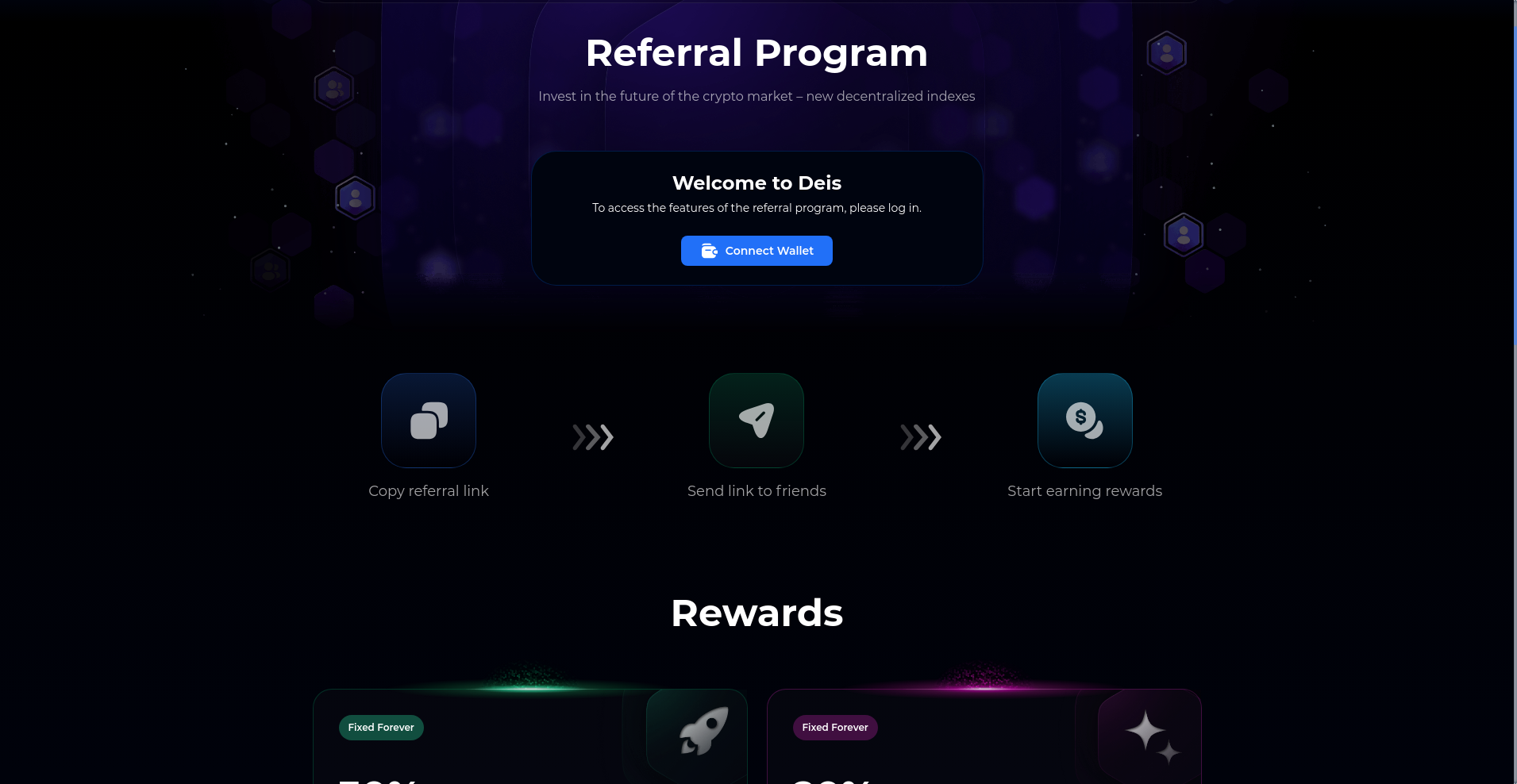DEIS Finance ($DEIS) Review: A Data-Driven Legitimacy and Risk Assessment

What Is DEIS Finance: An Introduction
DEIS Finance presents itself as a decentralized protocol aimed at simplifying crypto investment through index creation, management, and governance. Built on the BNB Chain, the project emphasizes automated, low-cost portfolio management, targeting long-term investors and DeFi enthusiasts.
This review offers an impartial evaluation of DEIS Finance, scrutinizing its technical framework, team credibility, security posture, tokenomics, ecosystem activity, and legal considerations. It aims to clarify the project’s strengths and weaknesses to inform potential investors and users alike.
The Team and Roadmap Evaluation
From the available data, DEIS Finance's team appears to lack publicly disclosed member profiles, with no specific founder backgrounds or prior experience explicitly highlighted. This anonymity or opacity is a common trait among newer DeFi projects but tends to impact trust and perceived credibility.
Assessing their roadmap, key milestones include:
- Q1-Q2 2025: Core protocol development & beta testing.
- Q3 2025: Smart contract audit and initial DEX offering (IDO).
- Q4 2025: Product launch, security review, and initial ecosystem expansion.
- 2026: Introduction of advanced features such as AI tools, multi-chain support, and dividend-based products.
While the milestones are logically sequenced, the lack of detailed technical and team-based transparency raises questions about execution capacity and accountability. The delay or absence of audits at certain points could hamper trust in their delivery potential.
Assessing the Security and Integrity of DEIS Finance
The security analysis is primarily based on the Cyberscope audit report, which indicates that the smart contract code has undergone a formal audit process. The audit highlights a high security score (~94.57%) and a community score in the lower 25th percentile, signaling some level of oversight but also room for improvement.
- Strengths: High overall security score, transparent audit process with detailed assessment.
- Weaknesses: The audit iteration reports mention a "high criticality" issue unresolved as of the latest update. The details of vulnerabilities or flaws are not explicitly disclosed, making it difficult to assess potential exploit vectors conclusively.
- Concerns: The absence of a comprehensive, multisource security review raises risks. Relying solely on Cyberscope’s report might overlook other vulnerabilities or updates not yet audited.
For potential investors, the single-sourced audit and unresolved critical issues suggest caution. Future audits and transparency will be critical to validate security claims and mitigate risks related to smart contract exploits or operational failures. Understanding critical vulnerabilities in smart contract audits is essential for evaluating such findings.
A Breakdown of DEIS Tokenomics
The DEIS token operates as the core utility and governance asset within the ecosystem. Total supply is fixed at 100 million tokens. Its distribution and economic design aim to promote sustainable growth and user engagement.
- Total Supply: 100,000,000 DEIS tokens.
- Allocation:
- IDO: 10% (10M)
- Treasury: 20% (20M)
- Marketing: 15% (15M)
- Liquidity (CEX & DEX): 15% (15M)
- Investment Funds: 20% (20M)
- Team & Advisors: 10% (10M)
- Safeguard Funds (SAFU): 10% (10M)
- Utility: Staking, governance voting, and protocol income sharing. Notably, some rewards come from direct revenue-sharing rather than inflationary minting.
- Incentives: Liquidity mining and staking rewards aim to bootstrap ecosystem assets, but could introduce inflationary pressures if emissions are high.
- Buyback & Burn: A portion of revenue will fund token repurchases, creating deflationary mechanisms and potentially supporting price stability.
While the economic model balances emission and incentive mechanisms, the lack of detailed emission rates, vesting schedules for the team, and governance policies suggests a partially opaque tokenomic design. This could pose long-term risks to hold and governance stability. Investors should pay close attention to token vesting schedules to assess team commitment and prevent early dumps.
Assessing DEIS Finance's Development and Ecosystem Activity
Based on the available updates, DEIS Finance has outlined a detailed roadmap targeting a broad suite of features, including index creation, automated rebalancing, AI integration, and multi-chain support. Their community engagement appears nascent but active, with airdrops and referral programs designed to incentivize early adoption.
Yet, developer activity signals are modest, with no concrete product launches or user-facing features confirmed as operational. The project's emphasis on security audits and partnerships with professional firms indicates an awareness of risk management, though real-world traction remains limited at this stage.
The low community score (community sentiment at ~35) reflects uncertainty or lack of widespread trust, which is typical for early-stage DeFi projects but warrants cautious monitoring. Understanding community sentiment analysis in crypto projects is a crucial part of due diligence.
Reviewing the Terms and Conditions
The project's publicly available documents do not reveal any overtly unfavorable or ambiguous legal clauses. However, the limited transparency on ongoing audits, governance rules, or legal compliance introduces potential long-term risks. The project claims to be "fully decentralized" and "non-custodial," but detailed terms governing user assets, dispute resolution, or regulatory adherence are not explicitly described.
As with many DeFi protocols, the absence of clear legal frameworks or compliance disclosures elevates risks for institutional or risk-averse investors.
Final Analysis: The Investment Case for DEIS Finance
DEIS Finance embodies many hallmarks of innovative DeFi projects — a focus on index-based investment, revenue-sharing mechanics, and forward-looking features like AI and multi-chain support. Its transparent audit by Cyberscope and defined tokenomics lend some credibility. However, significant concerns about the team’s visibility, unresolved security vulnerabilities, and early ecosystem traction temper the optimism.
Investors should weigh the potential for high returns if the platform successfully delivers on its roadmap against the risks of security flaws, execution issues, and regulatory ambiguity. The project’s reliance on community engagement strategies like referral programs and airdrops illustrates a common growth tactic but is less predictive of long-term viability.
Pros / Strengths
- Formal security audit with high overall score from Cyberscope
- Structured tokenomics balancing inflationary rewards with buyback mechanisms
- Innovative features like revenue-sharing staking, governance rights
- Clear roadmap focusing on multi-chain and AI integration
Cons / Risks
- Limited team transparency and public contributor information
- Critical vulnerabilities unresolved in the latest audit
- Early ecosystem traction with low community sentiment
- Potential regulatory uncertainty due to lack of comprehensive legal disclosures
- Dependence on successful execution of complex multi-feature development
In conclusion, DEIS Finance warrants cautious optimism. While its foundational structure and technical audits provide some reassurance, the opaque team profile, security concerns, and early-stage development trajectory suggest thorough due diligence before any significant capital allocation. Fundamental understanding of the platform’s technological robustness and adherence to transparent governance will be pivotal for assessing its long-term legitimacy and resilience.
